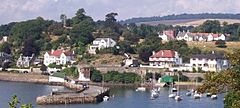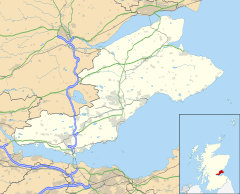Aberdour facts for kids
Quick facts for kids Aberdour
|
|
|---|---|
 A view across Aberdour Harbour |
|
| Population | 1,710 (2020) |
| OS grid reference | NT190852 |
| Council area | |
| Lieutenancy area | |
| Country | Scotland |
| Sovereign state | United Kingdom |
| Post town | BURNTISLAND |
| Postcode district | KY3 |
| Dialling code | 01383 |
| Police | Fife |
| Fire | Fife |
| Ambulance | Scottish |
| EU Parliament | Scotland |
| UK Parliament |
|
| Scottish Parliament |
|
Aberdour is a beautiful and old village located on the south coast of Fife, Scotland. It sits on the northern shore of the Firth of Forth. From Aberdour, you can look south towards the island of Inchcolm and its Abbey. You can also see Leith and Edinburgh in the distance.
In 2011, about 1,633 people lived in Aberdour. The village has a winding High Street that is a bit away from the coast. Small lanes branch off the High Street, leading to hidden parts of the village and the shoreline. Aberdour is nestled between the larger coastal towns of Burntisland to the east and Dalgety Bay to the west. The area around Aberdour, known as its parish, had a population of 1,972 in 2011.
Contents
What Does the Name Aberdour Mean?
The name Aberdour means 'mouth of the Dour'. The first part, aber, comes from an old language called Pictish. It means 'river mouth'. The Dour Burn is a small river that flows into the River Forth near the village's harbour.
The name Dour also comes from Pictish, meaning 'water'. You can find similar words in place names like Dover. Later, the Pictish word changed into the Scottish Gaelic word dobhar. Aberdour was first written down as "Abirdaur" in 1126 and "Abirdoure" in 1179.
A Glimpse into Aberdour's Past
For a long time, Aberdour was actually two separate villages: Wester Aberdour and Easter Aberdour. They were on opposite sides of the Dour Burn. However, when the railway arrived in the 1800s, the two villages grew together.
In the 1700s, Aberdour's harbour was improved with a stone pier. This helped with shipping coal from nearby mines. But in the 1850s, things changed a lot. Aberdour Harbour became a popular spot for fun steamer boats coming from Leith. This led to building a deeper pier at Hawkcraig, a bit further around the bay. Hotels and other services also started to appear, many of which you can still see today.
The railway came to Aberdour in 1890. It was built as an extension from the new Forth Bridge. The station has won many awards for being well-kept.
Exploring Aberdour's Geography
The A921 is the main road along Fife's south coast. It goes down the High Street of Wester Aberdour. Then, it turns sharply left to cross the railway line, and right again to go through Easter Aberdour's Main Street.
Wester Aberdour has a narrow road lined with shops and hotels. Many old buildings from the 1600s to early 1800s add to its historic feel. Near the railway bridge, three lanes continue east. These were probably part of the original High Street before the railway was built.
- One lane leads to Aberdour railway station. It's a beautiful, traditional station. Many people from the village use it to travel to work every day.
- A second lane goes alongside the railway line to Aberdour Castle.
- A third lane leads to the restored Aberdour House.
A bit further west, a narrow road called Shore Road leads down to the West Sands and the Harbour. This area is a highlight for many visitors. Parking here is often hard to find.
Another road goes towards the coast from Easter Aberdour. Hawkcraig Road passes St Fillan's Church and Silversand Park. This park is home to the Aberdour Shinty Club. The road continues to a parking area on Hawkcraig. This car park used to be a quarry for a type of rock called whinstone between 1910 and 1933. Later, it was a rubbish dump before becoming a car park in the 1970s. From here, it's a short walk to the Silver Sands, which is Aberdour's busiest beach.
On the west side of Hawkcraig Point, there is a short concrete jetty. This jetty was used to develop radio-controlled torpedoes during World War I. You can still see the old foundations of the Radio Hut hidden by the hill.
Famous Landmarks in Aberdour

Almost exactly between the two old villages, but technically part of Easter Aberdour, is Aberdour Castle. This castle started as a simple hall house in the 1200s. It was built on a spot overlooking the Dour Burn. The oldest part of the castle that still stands is one of the earliest stone castles in mainland Scotland.
Over the next 400 years, the castle was updated with new architectural styles. The parts built by the Earls of Morton in the late 1500s are especially notable. They show beautiful Renaissance details and are still mostly roofed.
A fire in the late 1600s damaged the castle. Some repairs were made, but in 1725, the family bought Aberdour House. This house was built in the 1600s and is on the west side of the burn in Wester Aberdour. The old medieval castle was then left to slowly fall apart. Today, Historic Environment Scotland looks after Aberdour Castle. It is open to the public, but there is an entrance fee. After being empty for a while, Aberdour House was turned into homes in the early 1990s.
Next to the castle is St Fillan's Church. This is one of the best-preserved medieval parish churches in Scotland. It mostly dates back to the 1100s. Originally, it was controlled by Inchcolm Abbey. A south arcade was added to the main part of the church in the early 1500s. This part is open in summer. In 2022, the Church of Scotland considered closing it, but a campaign was started to keep it open.
The Aberdour obelisk was built by Lord Morton. He built it when he moved from the village to a large home in Edinburgh. He wanted to be able to see his old hometown from his new house using binoculars. The obelisk stands in a cow field between the castle and the beach.
Aberdour's Culture and Community
Aberdour hosts an annual festival every year. It usually runs from late July to early August. The festival includes music, shows, sports, and events for children.
Aberdour has won several awards for its beauty. In 2005, it was a finalist in the "Beautiful Scotland in Bloom" awards. It was nominated for "Best Coastal Resort" in Scotland. In 2014, Aberdour was voted Best Coastal Village in Fife and Best Small Coastal Village in Scotland. It also received Gold Awards in Beautiful Fife and Beautiful Scotland. In 2018, The Sunday Times listed Aberdour as the second-best place to live in Scotland.
Aberdour is home to Fife's only senior shinty club. The Aberdour Shinty Club has teams for both men and women in the national leagues.
Aberdour's Beautiful Beaches
Aberdour has two main beaches: the Silver Sands and the Black Sands.
The Silver Sands are on the east side of the village. This beach has previously received a "Blue Flag" award. This award means the beach is very clean, has good facilities, is safe, and is well-managed. New facilities are being built by Fife Council to make the beach even better all year round.
The Black Sands, also known as the West Beach, have darker, rockier sand. This beach is popular with visitors who like to explore the rock caves and look for unique sea creatures. During the summer (April to September), dogs are not allowed on the Silver Sands. However, they are welcome all year round at the West Beach.
The two beaches are connected by part of the Fife Coastal Path. This path also takes hikers past the harbour and the Hawkcraig. Hawkcraig is a popular spot for rock climbing. Silver Sands is becoming more popular with people who enjoy open water swimming. They swim in the sea daily for fun and to train for competitions. The bay is safe from strong currents.
Some scenes from Richard Jobson's 2003 movie 16 Years of Alcohol were filmed at the Black Sands in Aberdour.
Discovering Inchcolm Island
The island of Inchcolm is about a quarter of a mile from Aberdour's shore. It is part of the Aberdour parish. Its name, Inchcolm, means "Island of Columba" in Gaelic. This suggests it has connections to Saint Columba from very early times. Although there are no written records before the 1100s, it might have been a special place for monks, like a small Iona in the east.
During the First and Second World Wars, the army used Inchcolm. It was part of the defenses for the Firth of Forth. You can still see many remains of gun placements and barracks from those times.
The island is famous for its wildlife, especially seabirds and seals. Many visitors come in summer to see them. The remains of the historic Abbey are also a popular attraction. Inchcolm is also a popular place for weddings.
Famous People from Aberdour
Some notable people who have lived in Aberdour include:
- Rev Robert Liston: A church leader who was Moderator of the General Assembly of the Church of Scotland in 1787.
- Geoffrey Keyes: A brave soldier who received the Victoria Cross award.
- William Wotherspoon: A well-known rugby union player.
Aberdour's Twin Town
Aberdour has a twin town:
- Corte Franca, Italy (since July 31, 2004)
See also
 In Spanish: Aberdour para niños
In Spanish: Aberdour para niños




